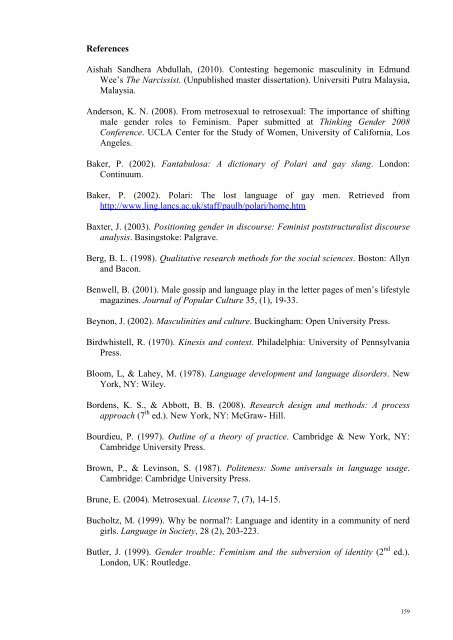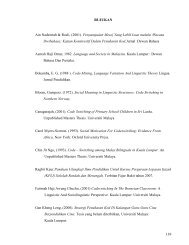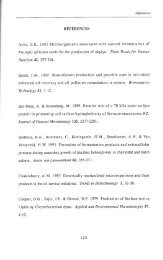CHAPTER ONE - UM Students' Repository
CHAPTER ONE - UM Students' Repository
CHAPTER ONE - UM Students' Repository
Create successful ePaper yourself
Turn your PDF publications into a flip-book with our unique Google optimized e-Paper software.
References<br />
Aishah Sandhera Abdullah, (2010). Contesting hegemonic masculinity in Edmund<br />
Wee’s The Narcissist. (Unpublished master dissertation). Universiti Putra Malaysia,<br />
Malaysia.<br />
Anderson, K. N. (2008). From metrosexual to retrosexual: The importance of shifting<br />
male gender roles to Feminism. Paper submitted at Thinking Gender 2008<br />
Conference. UCLA Center for the Study of Women, University of California, Los<br />
Angeles.<br />
Baker, P. (2002). Fantabulosa: A dictionary of Polari and gay slang. London:<br />
Continuum.<br />
Baker, P. (2002). Polari: The lost language of gay men. Retrieved from<br />
http://www.ling.lancs.ac.uk/staff/paulb/polari/home.htm<br />
Baxter, J. (2003). Positioning gender in discourse: Feminist poststructuralist discourse<br />
analysis. Basingstoke: Palgrave.<br />
Berg, B. L. (1998). Qualitative research methods for the social sciences. Boston: Allyn<br />
and Bacon.<br />
Benwell, B. (2001). Male gossip and language play in the letter pages of men’s lifestyle<br />
magazines. Journal of Popular Culture 35, (1), 19-33.<br />
Beynon, J. (2002). Masculinities and culture. Buckingham: Open University Press.<br />
Birdwhistell, R. (1970). Kinesis and context. Philadelphia: University of Pennsylvania<br />
Press.<br />
Bloom, L, & Lahey, M. (1978). Language development and language disorders. New<br />
York, NY: Wiley.<br />
Bordens, K. S., & Abbott, B. B. (2008). Research design and methods: A process<br />
approach (7 th ed.). New York, NY: McGraw- Hill.<br />
Bourdieu, P. (1997). Outline of a theory of practice. Cambridge & New York, NY:<br />
Cambridge University Press.<br />
Brown, P., & Levinson, S. (1987). Politeness: Some universals in language usage.<br />
Cambridge: Cambridge University Press.<br />
Brune, E. (2004). Metrosexual. License 7, (7), 14-15.<br />
Bucholtz, M. (1999). Why be normal?: Language and identity in a community of nerd<br />
girls. Language in Society, 28 (2), 203-223.<br />
Butler, J. (1999). Gender trouble: Feminism and the subversion of identity (2 nd ed.).<br />
London, UK: Routledge.<br />
159
Cameron, D. (1997). Performing gender identity: Young men’s talk and the<br />
construction of heterosexual masculinity. In Johnson, S., & Meinhof, U. H. (Eds.),<br />
Language and masculinity (pp. 47-64). Oxford, UK: Blackwell Publishers Ltd.<br />
Cameron, D. (1998). ‘Is there any ketchup, Vera?: Gender, power and pragmatics’.<br />
Discourse and Society, 9 (4), 437-455.<br />
Cameron, D. (2006b). On language and sexual politics. London, UK: Routledge.<br />
Cameron, D, & Coates, J. (1988). Some problems in in the sociolinguistic explanation<br />
of sex differences. In Cameron, D., & Coates, J. (Eds.), Women in their speech<br />
communities (pp. 13-26). London: Longman.<br />
Cameron, D., McAlinden, F. & O’Leary, K. (1988). Lakoff in context: The social and<br />
linguistic function of tag questions. In Coates, J. & Cameron, D. (Eds.), Women in<br />
their speech communities: New perspectives on language and sex (pp. 74-93). New<br />
York, NY: Longman.<br />
Cardonna, M. (2000). Vanity, they name is…man?. Advertising Age 71, (17), 24.<br />
Carr, D. (2003). New men’s fashion magazine. New York, NY: New York Times.<br />
Chafe, W. (1994). Discourse, consciousness and time: The flow and displacement of<br />
conscious experience in speaking and writing. Chicago: University of Chicago<br />
Press.<br />
Chafe, W. (1995). Polyphonic topic development. Symposium on Conversation 95.<br />
University of New Mexico, Alburqueque.<br />
Cheng, F. H., Ooi, C. S. & Ting, D. H. (2010). Factors affecting consumption behaviour<br />
of metrosexual toward male grooming products. International Review of Business<br />
Research Papers, 6 (1), 574-590.<br />
Coad, D. (2008). The metrosexual: Gender, sexuality and sport. Albany, NY: State<br />
University of New York Press.<br />
Coates, J. (1989). Gossip revisited: Language in all-female groups. In Coates, J., &<br />
Cameron, D. (Eds.), Women in their speech communities (pp. 94-121). Harlow:<br />
Longman.<br />
Coates, J. (1991). Women’s cooperative talk: A new kind of conversational duet?. In<br />
Uhlig, C., & Zimmermann, R. (Eds.), Proceedings of the Anglistentag 1990<br />
Marburg (pp. 196-211). Tübingen: Max Niemeyer Verlag.<br />
Coates, J. (1994). No gap, lots of overlap: Turn-taking patterns in the talk of women<br />
friends. In Graddol, D., Maybin, J., & Stierer, B. (Eds.). Researching language and<br />
literacy in social context (pp. 177-192). Cleveland: Multilingual Matters.<br />
Coates, J. (1996). Women talk: Conversation between women friends. Oxford, UK:<br />
Blackwell.<br />
160
Coates, J. (1997). One-at-a-time: The organization of men’s talk. In Johnson, S., &<br />
Meinhof, U. H. (Eds.). Language and masculinity (pp. 107-129). Oxford, UK:<br />
Blackwell Publishers Ltd.<br />
Coates, J. (2003). Men talk: Stories in the making of masculinities. Oxford, UK:<br />
Blackwell Publishers Ltd.<br />
Cohen, L., Manion, L., & Morrison, K. (2000). Research methods in education (5 th ed.).<br />
London and New York, NY: Routledge.<br />
Connell, R. W. (1995). Masculinities. Berkeley & Los Angeles, California: University<br />
of California Press.<br />
Conseur, A. A. (2004). Factors influencing the emergence of the metrosexual.<br />
(Unpublished master dissertation). University of Georgia, Athens, GA, USA.<br />
Creswell, J. W. (1998). Qualitative inquiry and research design: Choosing among five<br />
traditions. Thousand Oaks, CA: Sage.<br />
Davies, B. (2005). Communities of practice: Legitimacy not choice. Journal of<br />
Sociolinguistics, 9, 557-581.<br />
Denk, K. (2009). Catering to the Metrosexual Man. Retrieved from<br />
http://www.allacademic.com/meta/p306152_index.html.<br />
Denzin, N. K. (1970). The research act in Sociology: A theoretical introduction to<br />
Sociological methods. London: Butterworth.<br />
Dunbar, R. I. M. (1993). Coevolution of neocortical size, group size and language in<br />
humans. Behavioral and Brain Sciences 16, (4), 681–735.<br />
Donna, C. B. (2004). From grudginator to experimenter. Global Cosmetic Industry 172,<br />
(3), 21-21.<br />
Donoghue, L. (2005). Men choose science or simplicity? Global Cosmetic Industry 173,<br />
(9), 30-32.<br />
Doublekova, P. (2008). “The metrosexual man” appearance in Bulgaria: A Western<br />
trend in a post-state Socialism context. (Unpublished master dissertation). Central<br />
European University, Budapest, Hungary.<br />
Eckert, P. (1999). Linguistic variation as social practice. Oxford, UK: Blackwell.<br />
Eckert, P., & McConnell-Ginet, S. (1992). Think practically and look locally: Language<br />
and gender as as community-based practice. Annual Review of Anthropology, 21,<br />
461-490.<br />
Eckert, P., & McConnell-Ginet, S. (2003). Language and gender. Cambridge:<br />
Cambridge University Press.<br />
Edelsky, C. (1981). Who’s got the floor? Language in Society, 10 (3), 383-442.<br />
161
Edwards, T. (1997). Men in the mirror: Men’s fashion, masculinity and consumer<br />
society. London: Cassell.<br />
Eggins, S., & Slade, D. (1997). Analysing casual conversation. London: Cassell.<br />
Erikson, E. H. (1950). Childhood and society. New York: Norton. p. 242.<br />
Erickson, E. (1956). The problem of ego identity. Journal of Psychoanalytic<br />
Association, (4), 54-121.<br />
Falk, J. (1980). The conversational duet. Proceedings of the 6 th Annual Meeting of the<br />
Berkeley Linguistics Society, 6, 507-514.<br />
Fausto-Sterling, A. (2000). Sexing the body: Gender politics and the construction of<br />
sexuality. New York, NY: Basic Books.<br />
Flocker, M. (2003). The metrosexual guide to style. Cambridge: DeCapo Press.<br />
Foucault, M. (1980). Power/knowledge: Selected interviews and other writings 1972-<br />
1977. New York, NY: Pantheon.<br />
Fox, H. E., White, S. A., Kao, M. H., & Fernald, R. D. (1997). Stress and dominance in<br />
a social fish. Journal of Neuroscience, 17, 6463-6469.<br />
Fromkin, V., & Rodman, R. (1998). An introduction to language (6 th ed.). Orlando, FL.:<br />
Harcourt Brace College Publishers.<br />
Garner, D., Garfinkel, P., Schwartz, D., & Thompson, M (1980). Cultural expectations<br />
of thinness on women. Psychological Reports, 47, 483-491.<br />
Gray, J. (1992). Men are from Mars, women are from Venus. New York, NY: Harper<br />
Collins.<br />
Grogan, S., & Richards, H. (2002). Body image focus groups with boys. Men and<br />
Masculinities 2, (3), 219-232.<br />
Haas, A. (1979). Male and female spoken language differences: Stereotypes and<br />
evidence. Psychological Bulletin 86, 616-626.<br />
Hackberth, A. (2003). Vanity, thy name is metrosexual. Washington Post. Retrieved<br />
from http://www.washingtonpost.com/ac2/wp-dyn?<br />
Hall, K. (1995). Lipservice on the fantasy lines. In Hall, K. & Bucholtz, M. (Eds.),<br />
Gender articulated: Language and the socially constructed self (pp. 183-216).<br />
London, UK: Routledge.<br />
Haywood, C., & Mac an Ghaill, M. (2003). Men and masculinities. Open University<br />
Press.<br />
Helgeson, V. (2002). The psychology of gender. Upper Saddle River, New Jersey, NJ:<br />
Prentice Hall.<br />
162
Hewitt, R. (1997). ‘Box-out’ and ‘Taxing’. In Johnson, S., & Meinhof, U. H. (Eds.).<br />
Language and masculinity (pp. 27-46). Oxford, UK: Blackwell Publishers Ltd.<br />
Holmes, J. (1995). Women, men and politeness. London, UK: Longman Group Limited.<br />
Holmes, J. (1999). Communities of practice in language and gender research (Ed.).<br />
Special issue of Language in Society 28, (2), 171-320.<br />
Holmes, J. (2008). An introduction to Sociolinguistics (3 rd ed.). London, UK: Pearson<br />
Education Limited.<br />
Janowska, K. (2008). Metrosexual men’s shopping habits: Study of the modern men’s<br />
clothing brabd selection. (Unpublished bachelor thesis). Växjö University, Sweden.<br />
Jariah Mohd Jan, (1999). Malaysian talk shows: A study of power and solidarity in<br />
inter-gender verbal interactions. (Unpublished doctoral dissertation). University of<br />
Malaya: Kuala Lumpur.<br />
Jespersen, O. (1922). Language: Its nature development, and origin. New York, NY:<br />
W. W. Norton.<br />
Johnson, S. (1997). Theorizing language and masculinity: A feminist perspective. In<br />
Johnson, S., & Meinhof, U. H. (Eds.). Language and masculinity (pp. 8-26). Oxford,<br />
UK: Blackwell Publishers Ltd.<br />
Johnson, S., & Finlay, F. (1997). Do men gossip? An analysis of football talk on<br />
television. In Johnson, S., & Meinhof, U. H. (Eds.). Language and masculinity (pp.<br />
130-143). Oxford, UK: Blackwell Publishers Ltd.<br />
Johnson, S., & Meinhof, U. H. (1997). Language and masculinity. (Ed.). Oxford, UK:<br />
Blackwell Publishers Ltd.<br />
Jones, D. (1980). Gossip: Notes on women’s oral culture. Women’s Studies<br />
International Quarterly, 3, 193-198.<br />
Kaye, J. (2009). Twenty-first-century Victorian dandy: What metrosexuality and the<br />
heterosexual matrix reveal about Victorian men. Journal of Popular Culture 42, (1),<br />
103-125.<br />
Kiesling, S. F. (1997). Power and the language of men. In Johnson, S., & Meinhof, U.<br />
H. (Eds.). Language and masculinity (pp. 65-85). Oxford, UK: Blackwell Publishers<br />
Ltd.<br />
Klein, J. (1971). The family in “traditional’ working-class England. In Anderson, M.<br />
(Ed.). Sociology of the family. Baltimore, MD: Penguin Books.<br />
Kramer, C. (1974b). Women’s speech: Separate but unequal?. Quarterly Journal of<br />
Speech 60, 14-24.<br />
Komarovsky, M. (1967). Blue-collar marriage. New York, NY: Vintage Books.<br />
Lakoff, R. (1973). Language and woman’s place. Language in Society, 2, 45-80.<br />
163
Lakoff, R. (1975). Language and women’s place. New York, NY: Harper Colophon.<br />
Landis, C. (1927). National differences in conversations. Journal of Abnormal and<br />
Social Psychology, 21, 354-357.<br />
Landis, M. H., & Burtt, H. E. (1924). A study of conversations. Journals of<br />
Comparative Psychology, 4, 81-89.<br />
Langer, E. (1970a). The women of the telephone company: Part 1. New York Review of<br />
Books, 20-24.<br />
Langer, E. (1970b). The women of the telephone company: Part 1. New York Review of<br />
Books, 16-22.<br />
Lave, J., & Wenger, E. (1991). Situated learning: Legitimate peripheral participation.<br />
Cambridge, UK: Cambridge University Press.<br />
Lave, J., & Wenger, E. (1998). Communities of practice: Learning, meaning and<br />
identity. Cambridge, UK: Cambridge University Press.<br />
Likert, R. (1932). A technique for measurement of attitudes. New York, NY: Columbia<br />
University Press.<br />
Litosseliti, L. (2006). Gender and language: Theory and practice. New York, NY:<br />
Oxford University Press.<br />
Martin, M., & Kennedy, P. (1994). The measurement of social comparison to<br />
advertising models: A gender gap revealed. In Costa, J. (Ed.), Gender issues and<br />
consumer behaviour (pp. 104-124). Thousand Oaks, CA: Sage Publications.<br />
Mashudi, B. H. K. (1981). The syntax of Malay interrogatives. Kuala Lumpur: Dewan<br />
Bahasa dan Pustaka.<br />
McConnell-Ginet, S. (2003). “What’s in a name?”: Social labelling and gender<br />
practices. In Holmes, J., & Meyerhoff, M. (Eds.). The handbook of language and<br />
gender (pp. 69-97). Oxford, UK: Blackwell Publishing Ltd.<br />
McElhinny, B. (2003). Theorizing gender in sociolinguistics and linguistic<br />
Anthropology. In Holmes, J., & Meyerhoff, M. (Eds.). The handbook of language<br />
and gender (pp. 21-37). Oxford, UK: Blackwell Publishing Ltd.<br />
Mehrabian, A. (1981). Silent messages: Implicit communication of emotion and<br />
attitudes (2 nd ed.). Belmont, CA: Wadsworth.<br />
Merriam, S. B. (1998). Qualitative research and case study applications in education.<br />
San Francisco, SF: Jossey-Bass.<br />
Meyerhoff, M. (2003). Claiming a place: Gender, knowledge and authority as emergent<br />
properties. In Holmes, J., & Meyerhoff, M. (Eds.). The handbook of language and<br />
gender (pp. 302-326). Oxford, UK: Blackwell Publishing Ltd.<br />
164
Mishkind, M., Rodin, J., Silberstein, L., & Streigel-Moore, R. (1986). The embodiment<br />
of masculinity: Cultural psychological and behavioural dimensions. In Kimmel, M.<br />
(Ed.), Changing men: New directions in research in men and masculinity (pp. 37-<br />
52). Newbury Park, CA: Sage.<br />
Moerman, M., & Sack, H. (1971). On ‘understanding’ in the analysis of natural<br />
conversation. Paper given at the 70 th Annual Meeting of the American<br />
Anthropological Association.<br />
Moore, H. T. (1922). Further data concerning sex differences. Journal of abnormal and<br />
social psychology 4, 81-89.<br />
Morgan, M. (1994). No woman, no cry: The linguistic representation of African<br />
American women. In Bucholtz, M., Liang, A. C., Sutton, L., & Hines, C. (Eds.),<br />
Cultural performances: Proceedings of the third Berkeley women and language<br />
conference (pp. 525-541). Berkeley, CA: Berkeley Women and Language Group,<br />
University of California.<br />
Mort, F. (1996). Cultures of consumption: Masculinities and social space in late<br />
twentieth century Britain. London: Routledge.<br />
Mulcaby, G. A. (1973). Sex differences in patterns of self-disclosure among<br />
adolescents: A developmental perspective. Journal of Youth and Adolescence, 4,<br />
343-356.<br />
Nickel (2004). Today’s metrosexual. Global Cosmetic Industry, 172 (1), 45.<br />
Nixon, S. (1996). Hard looks: Masculinities, spectatorship and contemporary<br />
consumption. London: UCL Press.<br />
O’Shaughnessy, M., & Stadler, J. (2005). Media and society: An introduction. (3 rd ed.).<br />
Oxford: Open University Press.<br />
Offord, B. (2003). Homosexual rights as human rights: Activism in Indonesia,<br />
Singapore and Australia. Oxford: Peter Lang International Academic Publishers.<br />
Ochs, E. (1992). Indexing gender. In Duranti, A., & Goodwin, C. (Eds.), Rethinking<br />
context: Language as an interactive phenomenon (pp. 335-358). Cambridge:<br />
Cambridge University Press.<br />
Parobková, M. (2009). Metrosexuals in American culture. (Unpublished bachelor<br />
thesis). Tomas Bata University, Zlín.<br />
Peterson, A. (2003). Research on men and masculinities: Some implications of recent<br />
theory for future work. Men and Masculinities, 6, 54-69. doi:<br />
10.1177/1097184X02250843<br />
165
Peterson, P. (1976). An investigation of sex differences in regard to nonverbal body<br />
gestures. In Eakins, B., Eakins. G, & Lieb-Brilhart, B. (Eds.). Siscom ’75: Women’s<br />
(and men’s) communication (pp. 20-27). Falls Church, VA: Speech Communication<br />
Association.<br />
Pruekchaikul, K. (2010). Metrosexual men in advertisements: A contrastive study.<br />
Paper submitted at the 11 th Graduate Research Conference (pp. 1094-1104). Khon<br />
Khaen University, Thailand.<br />
Pujolar, J. (1997). Masculinities in multilingual setting. In Johnson, S., & Meinhof, U.<br />
H. (Ed.). Language and masculinity (pp. 86-106). Oxford, UK: Blackwell<br />
Publishers Ltd.<br />
Rose, R., Gordon, T., & Bernstein, I. (1972). Plasma testosterone levels in the male<br />
rhesus monkey: Influences of sexual and social stimuli. Science, 178, 634-645.<br />
Sacks, H., Schlegoff, E. A., & Jefferson, G. (1974). A simplest systematics for the<br />
organization of turn-taking in conversation. Language, 50, 696-735.<br />
Sause, E. F. (1976). Computer content analysis of sex differences in the language of<br />
children. Journal of Psycholinguistic Research, 5, 311-324.<br />
Sidnell, J. (2003). Constructing and managing male exclusivity talk-in-interaction. In<br />
Holmes, J., & Meyerhoff, U. H. (Eds.). The handbook of language and gender (pp.<br />
327-352). Oxford, UK: Blackwell Publishers Ltd.<br />
Silverman, D. (1993). Interpreting qualitative data. London: Sage Publications.<br />
Simpson, M. (1994). Simpsonisms. The ‘Daddy’ of the Metrosexual, Retrosexual &<br />
Spawner of Sporno. Retrieved from http://www.marksimpson.com/simpsonisms/<br />
Simpson, M. (2006e). Metro-warriors. The Independent. Retrieved from<br />
http://www.marksimpson.com<br />
Simpson, P. (1993). Language, ideology and point of view. London, UK: Routledge.<br />
Simpson, P., & Myar, A. (2010). Language and power: A resource book for students.<br />
New York, NY: Routledge.<br />
Spender, D. (1980). Man made language. London, UK: Routledge and Kegan Paul.<br />
Stewart, L. P., Cooper, P. J., Stewart, A. D., & Friedley, S. A. (2003). Communication<br />
and gender. Boston, MA: Pearson Education, Inc.<br />
Stockwell, P. (2010). Sociolinguistics: A resource book for students (2 nd<br />
Routledge.<br />
ed.).<br />
Sunderland, Jane (2006). Gender and language: An advanced resource book.<br />
Routledge, London.<br />
Tannen, D. (1990). You just don’t understand: Women and men in conversation. New<br />
York, NY: Morrow, Ballentine.<br />
166
Thorne, B. & Stacey, J. (1993). The missing feminist revolution in sociology. In<br />
Kauffman (ed.), American feminist thought at century’s end (pp. 167-188).<br />
Cambridge, MA: Blackwell.<br />
Toolan, M. (1996). Total speech: An integrational approach to language. Durham, NC:<br />
Duke University Press.<br />
Veblen, T. B. (1899). The theory of the leisure class. Minneapolis: Dover Publications.<br />
Venn, J. (1880). On the diagrammatic and mechanical representation of propositions<br />
and reasonings. Dublin Philosophical Magazine and Journal of Science 10, (59), 1–<br />
18.<br />
Warren, S. J. (2003). Metrosexuals come out. New York Times. Retrieved from<br />
http://proquest.umi.com.ezproxy.lib.monash.edu.au/pqdweb?index=4&did=35001<br />
Wenger, E. (2006, June). Communities of practice: A brief introduction. Retrieved from<br />
http://www.ewenger.com/theory/index.htm<br />
Wenger, E., McDermott, R., & Snyder, W. (2002). Cultivating communities of practice:<br />
A guide to managing knowledge (1 st ed.). Cambridge, MA: Harvard Business School<br />
Press.<br />
West, C. & Zimmerman, D. H. (1983). Small insult: A study of interruptions in crosssex<br />
conversations between unacquainted persons. In Thorne, B., Kramarae, C. &<br />
Henley, N. (Eds.), Language, gender and society (pp. 102-117). Rowley, MA:<br />
Newbury House.<br />
West, C., & Zimmerman, D. H. (1987). Doing gender. Gender and society, 1, 125-151.<br />
White, L. (1994). Between Gluckman and Foucault: Historicizing rumour and gossip.<br />
Social Dynamics 20, (1), 75-92.<br />
Wodak, R. (1997). Gender and discourse (Ed.). London: Sage.<br />
167








